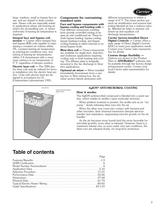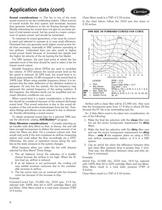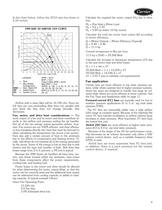
Catalog excerpts

AERO® 39MN,MW03-110 Indoor and Weathertight Outdoor Air Handlers Product Data Carrier’s 39M air handlers offer: • Units are shrink wrapped for complete protection while in transit • Factory-supplied variable frequency drives that are programmed and started up at the factory • Sealed panel double-wall R-13 insulation system • Stacked indoor unit configurations for application versatility and maximum space utilization • Outdoor weathertight cabinets have sloped roofs to prevent standing water, and are gasketed in all critical areas. • Factory-installed integral face and bypass coils for extreme conditions • Factory-installed humidifiers for precise indoor climate conditioning • Available factory-mounted controls, starters, disconnects and variable frequency drives • AHUBuilder® software for easy unit selection • Optional prepainted unit exterior • Optional AgION® anti-microbial coated panel interior • Optional factory-installed UV-C germicidal lamps Features/Benefits The Aero 39M air handler is the only unit on the market that practically installs itself. Easy installation Frames, corners and base rails of the 39M air handler are all easily disassembled and reassembled in minutes with as little as 3 standard tools. Carrier’s 39M units can be ordered with shipping splits, which speed section to section assembly. All panels are easily removed in one piece for cleaning or access to components.
Open the catalog to page 1
Features/Benefits (cont) Redefining flexibility Standard stacked fans and exhaust box sections reduce the footprint of the unit and ensure economical use of building space. Accessibility is required from only one side of the unit, increasing location options. This may result in floor space savings of 20% over competitive units. The use of non-staggered coils allows flat and cartridge style filter sections to maintain face velocities of 500 fpm or less at nominal airflow. Low velocity angle filtration sections typically have velocities of 350 fpm or less. Custom engineered for durability and...
Open the catalog to page 2
large, medium, small or bypass face areas, and are sloped to drain condensate. Steam coils are especially suited to applications where sub-freezing air enters the air-handling unit, or where uniformity of leaving-air temperature is required. Integral face and bypass coil section — Carrier offers integral face and bypass (IFB) coils capable of maintaining a constant air volume within 5%, constant leaving-air temperature as entering-air conditions vary, and mixing of leaving-air temperatures within 3 ft downstream with a maximum variance in air temperature of 5° F, regardless of damper...
Open the catalog to page 3
AHRI certification Carrier 39 Series air handler units are rated and certified in accordance with AHRI (Air Conditioning, Heating, and Refrigeration Institute) Standard 430, which is the industry standard for central station air-handling units. Certification by participating manufacturers of units within the scope of this program requires that the ratings and performance of any central station unit certified to AHRI be established in accordance with the AHRI Standard. Coils installed in the Carrier 39 Series air handler units are rated and certified in accordance with AHRI Standard 410....
Open the catalog to page 4
Application data Central station air handler Face and bypass units The central station air handler is a heating, ventilating, or air-conditioning unit that is centrally located in, or on, a building or structure. The air handler distributes air to desired areas through a system of ducts. The 39M factory packaged unit Individual components, such as fans, coils, and filters, are assembled at the factory. Packaged equipment is less costly than field-fabricated equipment and does not require assembly. The basic air-handling unit consists of a fan section and a coil section. Other components,...
Open the catalog to page 5
Application data (cont) Multizone — Mixing dampers blend hot-deck and colddeck temperatures to produce a desired temperature for individual zones. Several blending dampers per unit produce independent zones, each responding to its own thermostat (indoor unit only). ZONING DAMPERS High filtration units High filtration units employ a filter section ahead of the cooling and heating coils. A second filter section, called a final filter, is placed at the end of the unit at the point where the air enters the ductwork. DIF- FINAL FUSER FILTER Fans The 39M central station air handlers use...
Open the catalog to page 6
Fan selection criteria System requirements — The major factors that influence fan selection are airflow, external static pressure, fan speed, brake horsepower, and sound level. Additional system considerations include the fan control method, overloading, and non-standard air density. Fan selection for air-conditioning service usually involves choosing the smallest fan that provides an acceptable level of performance, efficiency and quality. Pressure considerations — The static pressure is the resistance of the combined system apart from the fan. Contributors to static pressure include other...
Open the catalog to page 7
Application data (cont) Clean filters result in a TSP of 2.55 inches. In the chart below, follow the 1010 rpm line down to 2.55 inches. 39M SIZE 30 FORWARD-CURVED FAN CURVE 8 MSE 7 Sound considerations — The fan is one of the main sound sources in an air-conditioning system. Other sources of sound include the duct system and terminals, because they generate turbulence in the air flowing through them. Simply estimating fan sound does not give an accurate picture of total system sound, but fan sound is a major component of system sound, and should be minimized. To minimize its sound...
Open the catalog to page 8
In the chart below, follow the 2210 rpm line down to 2.55 inches. 39M SIZE 30 AIRFOIL FAN CURVE 11 MSE Calculate the total fan motor heat output (Q) according to motor efficiency: Q = (Motor Output) ÷ (Motor Efficiency [Typical]) Q = 9.89 ÷ 0.86 Q = 11.5 hp Convert horsepower to Btu per hour. 11.5 hp x 2545 = 29,268 Btuh Calculate the required fan motor output (Hp) due to drive loss. Hp = (Fan bhp) x (Drive Loss) Hp = 9.6 x 1.03 Hp = 9.89 hp (select 10 Hp motor) — Rpm — Bhp (Brake Horsepower) MSE — Max. Static Eff. RP — Rated Point SC — System Curve Airflow with a clean filter will be...
Open the catalog to page 9All Carrier| Commercial Systems North America catalogs and technical brochures
-
WeatherMaker® 50TCQ
116 Pages
-
INFINITY™ 38MPRA
2 Pages
-
ActivAIR™ 36CB
24 Pages
-
ACTIVAIR™ 36IB
44 Pages
-
Axis™
2 Pages
-
AHUBuilder
2 Pages
-
PERFORMANCE™ 50VL-A
6 Pages
-
50ZPB
4 Pages
-
PERFORMANCE™ 50VT-A
6 Pages
-
Carrier® Ductless Systems
8 Pages
-
39CC
2 Pages
-
ActivAIR™ Induction Beams
2 Pages
-
Axis™ Overhead Air Terminals
2 Pages
-
Aero® 39M Air Handlers
2 Pages
-
A World of Comfort
2 Pages
-
Special Seismic Compliance
1 Pages
-
17DA Centrifugal Chiller
2 Pages
-
Air Handling Units 39 HQ
6 Pages
-
48P WEATHERMASTER®
168 Pages
-
48A WEATHERMAKER®
116 Pages
-
48PG CENTURION?
107 Pages
-
48PM CENTURION?
64 Pages
-
48TC WEATHERMAKER®
116 Pages
-
48HC WEATHERMASTER®
124 Pages
-
48LC WEATHEREXPERT®
52 Pages
-
48VL Performance? 14
32 Pages
-
48XL-A
30 Pages
-
48XL Infinity? 15
26 Pages
-
OMNIZONE?
80 Pages
-
16TJ
32 Pages
-
AQUASNAP® 30MPA,MPW015-045
36 Pages
-
EVERGREEN® 30HXA,HXC076-271
52 Pages
-
AQUAFORCE® 30XW150-400
60 Pages
-
EVERGREEN® 23XRV
32 Pages
-
AQUAFORCE® 30XA
150 Pages
-
30RB AQUASNAP®
92 Pages
-
30RAP AQUASNAP®
88 Pages
-
39S
36 Pages
-
39L AERO®
52 Pages
-
19XR EVERGREEN®
56 Pages
-
Aero Air-Handling Units
2 Pages




















































